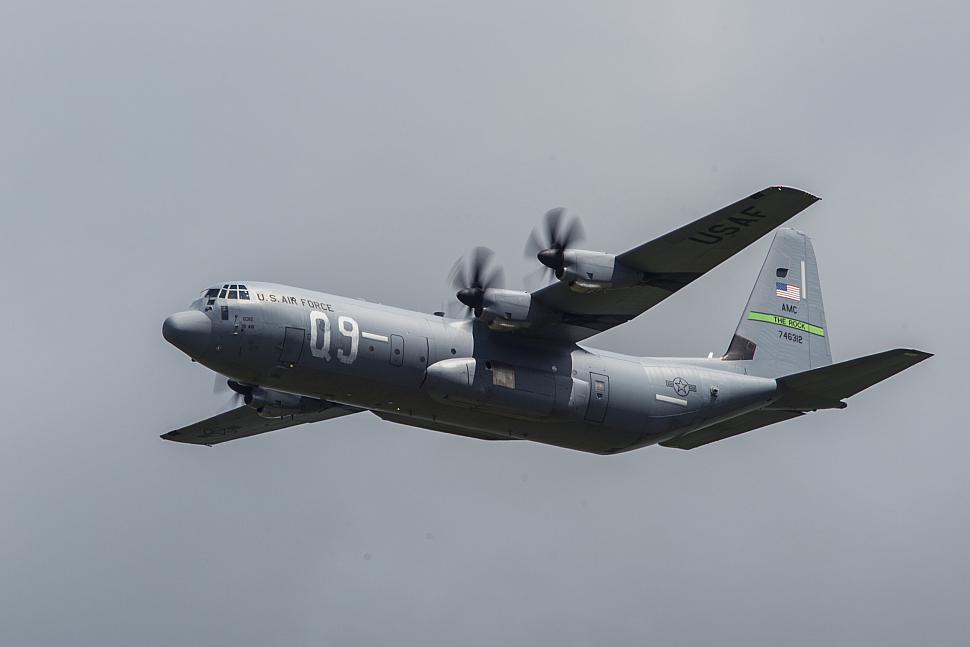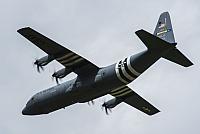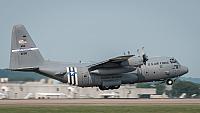C-130 News
C-130 Hercules News
Legacy Airlift Squadrons return to Normandy 75 years
June 6, 2019 (by
SrA Devin Rumbaugh) -
W7. Q9. E5. 6Z. These may just seem like letters and numbers to some. But these were the letters and numbers painted on the noses of Douglas C-47 Dakota units to identify which squadron the aircraft belonged to. With accompanying white and black invasion stripes painted on the wings and tail, the allied forces were easily identifiable, as they began the largest seaborne invasion in history, storming the beaches of Normandy on June 6th, 1944.

The painted letters and number W7, Q9, E5, and 6Z were the identifiers for the 37th, 61st, 62nd, and 96th Troop Transport Squadrons, who’s legacy lived on in Airlift Squadrons who supported the 75th Anniversary of D-Day.
The 37th Airlift Squadron, now located at Ramstein Air Base, Germany, lead the charge in supporting the 75th Anniversary of D-Day with a fleet of C-130J Super Hercules painted to match the 37th TCS’ legacy C-47s with the W7 designation, also known as “Whiskey 7.”
“Seeing the invasion stripes (on our aircraft) was amazing because it’s one thing to see the old videos with the stripes and the pictures that are posted all over our squadron, but it’s another to feel it,” said U.S. Air Force Maj. James Vanderneck, 37th Airlift Squadron chief of tactics and D-Day 75 mission commander. “To be able to go out there and fly around C-47s in the air and hear the thrum of C-47s as they go overhead and see one of them take off with one of our tails in the background painted up with the same invasion stripes.”
On June 4th, 1944, 48 hours prior to the invasion, orders were given to paint the aircraft with the stripes and designations to provide coordination between the ground parties and the air parties.
On the evening of June 5, 1944, the 37th was on their way to Iron Mike Drop zone to conduct personnel drops. During the flight, there was a layer of fog that created a lot of issues with getting all the aircraft in the right position in order to fly and drop where they are supposed to. However, the 37th TCS and sister squadrons were able to drop right over their target to the level of effect, where within 45 minutes, the troops they dropped were assembled and ready to go seize their objective, which was St. Mere Eglise.
Throughout the rest of the events on the 6th, the 37th were able to successfully drop the rest of their cargo and paratroopers on their designated targets.
The Battle Honors documented, presented to the 316th Troop Carrier Group, whom the 37th TCS fell under, stated, “Flying in unarmed and unarmored troop carrier aircraft, at minimum altitudes and air speeds, in unfavorable weather conditions, over water, and into the face of strong enemy defenses, without possibility of employing evasive actions, the planes of this group unloaded their paratroops with extreme precision over vital zones as part of the troop carrier spearhead of the allied invasion of the European continent. To the smooth cooperative effort of all members of the 316th TCG is attributable to this tremendous success of its participation in the initial phases of the invasion of Normandy. Their conduct has added luster to the traditions of our military forces,” signed by then U.S. Army Chief of Staff Brig. Gen. Victor Herbert Strahm.
With the missions completed within St. Mere Eglise community, the 37th AS conducted a number of flyovers for ceremonies held there.
“In terms of what it means to me personally, getting the chance to come out here and to do my best to commemorate those who did go before, remembering the people who made a name for the 37th Troop Carrier Squadron, not to build a name for themselves but to remember that they went out there, to do their best,” said Vanderneck. “To add to the efforts on the ground. It’s our jobs to rise to that level of innovation and have the same level of effectiveness.”
The 37th AS lead the charge, but received help from units like the 39th and 41st Airlift Squadrons at Dyess Air Force Base, Texas, the 61st and 62nd Airlift Squadrons at Little Rock Air Force Base, Ark., the 96th Airlift Squadron at Minneapolis-St. Paul Air Reserve Station, and the 123rd Airlift Wing, Kentucky Air National Guard.
“I think we’ve done an amazing job. Clearly the mission we came out here to do is maximize the commemoration of the 75th anniversary of D-Day, and to remember the sacrifice and efforts of those before us. We have come out here in past years, and by the end, we will have conducted 44 flyovers.”

USAF C-130J #07-46312 from 61st AS, Little Rock AFB, flies over Cherbourg-Maupertus Airport on June 6, 2019. The 61st AS’ lineage stems from the 61st Troop Carrier Squadron, who wore the “Q9” identifier during the airdrops conducted over Normandy during Operation Neptune June 6, 1944. [USAF photo by SrA Devin M. Rumbaugh]
The 37th Airlift Squadron, now located at Ramstein Air Base, Germany, lead the charge in supporting the 75th Anniversary of D-Day with a fleet of C-130J Super Hercules painted to match the 37th TCS’ legacy C-47s with the W7 designation, also known as “Whiskey 7.”
“Seeing the invasion stripes (on our aircraft) was amazing because it’s one thing to see the old videos with the stripes and the pictures that are posted all over our squadron, but it’s another to feel it,” said U.S. Air Force Maj. James Vanderneck, 37th Airlift Squadron chief of tactics and D-Day 75 mission commander. “To be able to go out there and fly around C-47s in the air and hear the thrum of C-47s as they go overhead and see one of them take off with one of our tails in the background painted up with the same invasion stripes.”
On June 4th, 1944, 48 hours prior to the invasion, orders were given to paint the aircraft with the stripes and designations to provide coordination between the ground parties and the air parties.
On the evening of June 5, 1944, the 37th was on their way to Iron Mike Drop zone to conduct personnel drops. During the flight, there was a layer of fog that created a lot of issues with getting all the aircraft in the right position in order to fly and drop where they are supposed to. However, the 37th TCS and sister squadrons were able to drop right over their target to the level of effect, where within 45 minutes, the troops they dropped were assembled and ready to go seize their objective, which was St. Mere Eglise.
Throughout the rest of the events on the 6th, the 37th were able to successfully drop the rest of their cargo and paratroopers on their designated targets.
The Battle Honors documented, presented to the 316th Troop Carrier Group, whom the 37th TCS fell under, stated, “Flying in unarmed and unarmored troop carrier aircraft, at minimum altitudes and air speeds, in unfavorable weather conditions, over water, and into the face of strong enemy defenses, without possibility of employing evasive actions, the planes of this group unloaded their paratroops with extreme precision over vital zones as part of the troop carrier spearhead of the allied invasion of the European continent. To the smooth cooperative effort of all members of the 316th TCG is attributable to this tremendous success of its participation in the initial phases of the invasion of Normandy. Their conduct has added luster to the traditions of our military forces,” signed by then U.S. Army Chief of Staff Brig. Gen. Victor Herbert Strahm.
With the missions completed within St. Mere Eglise community, the 37th AS conducted a number of flyovers for ceremonies held there.
“In terms of what it means to me personally, getting the chance to come out here and to do my best to commemorate those who did go before, remembering the people who made a name for the 37th Troop Carrier Squadron, not to build a name for themselves but to remember that they went out there, to do their best,” said Vanderneck. “To add to the efforts on the ground. It’s our jobs to rise to that level of innovation and have the same level of effectiveness.”
The 37th AS lead the charge, but received help from units like the 39th and 41st Airlift Squadrons at Dyess Air Force Base, Texas, the 61st and 62nd Airlift Squadrons at Little Rock Air Force Base, Ark., the 96th Airlift Squadron at Minneapolis-St. Paul Air Reserve Station, and the 123rd Airlift Wing, Kentucky Air National Guard.
“I think we’ve done an amazing job. Clearly the mission we came out here to do is maximize the commemoration of the 75th anniversary of D-Day, and to remember the sacrifice and efforts of those before us. We have come out here in past years, and by the end, we will have conducted 44 flyovers.”
Courtesy of 86th Airlift Wing/Public Affairs
Related articles:
Forum discussion:
Tags
- Kentucky Air Guard C-130s to fly in 75th Anniversary of D-Day (2019-05-31)
- Ramstein C-130Js with ‘invasion stripes’ head to Normandy for 75th D-Day anniversary (2019-05-29)
- C-130 Fighting Falcon news archive
Forum discussion:
- Start a discussion about this article in the C-130.net forum.
Tags
Additional images:

USAF C-130Js Hercules arrives at the Cherbuorg-Maupertus Airport carrying the 173rd Airborne Brigade Combat Team on June 1, 2019. More than 1,300 U.S. Service Members, partnered with 950 troops from across Europe and Canada, have converged in northwestern France to commemorate the 75th anniversary of Operation Overlord. [Army photo by Pfc. Richard Barnes, 7th Mobile Public Affairs Detachment]

USAF C-130J-30 #14-5802 from 62 AS Little Rock AFB, flies over Cherbourg-Maupertus Airport, France, June 6, 2019. The 62nd AS is a legacy squadron, stemming from the 62nd Troop Carrier Squadron, who conducted air drops with Douglas C-47 Dakotas during Operation Neptune June 6, 1944. [USAF photo by SrA Devin M. Rumbaugh]

USAF C-130J #07-46312 from the 165 AS takes off from the Kentucky ANGB in Louisville on June 1, 2019, en route to France, where it will participate in the 75th-anniversary reenactment of D-Day. The aircraft, which has been striped with historically accurate Allied Forces livery, will airdrop U.S. Army paratroopers over Normandy on June 9 as part of the commemoration. [ANG photo by Dale Greer]
